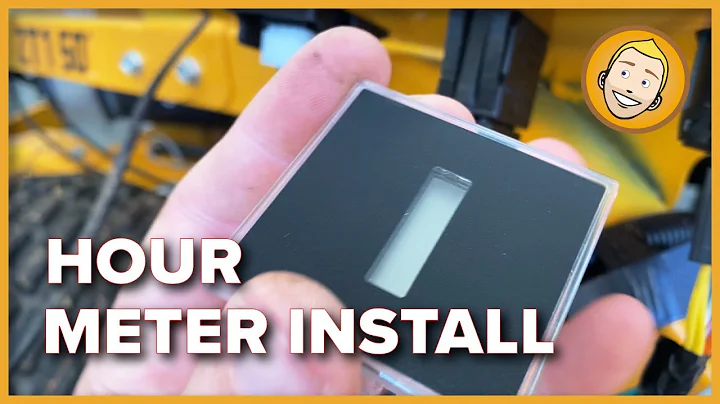Enhance Safety and Style with a Stair Hand Railing
Table of Contents
- Introduction
- Sizing Considerations for Stair Hand Railings
- Tools and Materials Needed
- Preparing the Railing
- Installing the Posts
- Installing the Anchors
- Securing the Handrail
- Adding the Covers
- Finalizing the Installation
- Conclusion
🛠️ Introduction
Installing a stair hand railing is a great way to enhance safety and add a touch of style to your stairs. In this tutorial, we will walk you through the step-by-step process of installing a hand railing that you can easily purchase from Amazon. Before we begin, it's important to consider the sizing of the railings and ensure you have the necessary tools and materials. So let's dive in and get started on this DIY project!
📏 Sizing Considerations for Stair Hand Railings
When selecting a stair hand railing, it's crucial to consider the sizing to ensure a proper fit. The distance between the posts may vary, especially when the railing is installed at an angle. Keep in mind that the size of the railing you purchase should accommodate the specific dimensions of your staircase. We recommend measuring the distance between the posts and taking into account any angles or curvature to ensure a seamless installation.
🔨 Tools and Materials Needed
To complete this installation, you will need the following tools and materials:
- Stair hand railing kit
- Hammer drill with a 10mm (3/8 inch) concrete drill bit
- Level
- Socket wrench or adjustable wrench
- Tape measure
- Painter's tape
- Screwdriver
- Anchors for concrete
- Screws for wood (optional)
- Covers for the anchors
Before you begin, double-check that you have all these items readily available. This will ensure a smooth and efficient installation process.
📐 Preparing the Railing
Start by laying out the stair hand railing on a protected surface to avoid any damage or scratches on the concrete. Assemble the railing loosely, ensuring that the threaded screws are inserted but not fully tightened. By leaving some flexibility, you will be able to adjust and position the railing accurately during the installation process.
Take this opportunity to slide the covers for the anchors onto the railing if they are not pre-assembled. This will save you time and effort later on. Secure these covers temporarily with painters tape to keep them out of the way during the installation.
🏗️ Installing the Posts
Begin by installing one of the posts, securing it to the concrete surface. Use a hammer drill with a 10mm (3/8 inch) concrete drill bit to create the anchor holes. Ensure that the post is plumb (straight up and down) before marking and securing the other post.
Once the anchor holes are drilled, carefully whack the concrete anchors into place. Some anchors may slide in easily, while others may require a bit of force. Use a level to ensure that each post remains plumb during this process.
Ideally, a socket wrench should be used to tighten the anchors securely. However, if a socket wrench is not available, an adjustable wrench can be used as a substitute.
⚙️ Installing the Anchors
With the posts securely in place, proceed with drilling the anchor holes for the bottom post. If necessary, remove the top post temporarily to provide better access for drilling. Once the holes are drilled, insert the concrete anchors and pound them into place.
To ensure a sturdy railing, be sure to tighten all the anchors firmly. Tighten them until they are completely secure and provide minimal wobbling. This will guarantee the overall stability and safety of the handrail.
🔒 Securing the Handrail
Now that the posts and anchors are in place, it's time to secure the handrail itself. Begin by tightening the threaded screws that hold the metal pieces together. Work systematically, starting with the handrails, then the middle support beam, and finally the top rail. This will ensure that the entire railing is securely fastened.
Once the railing is tightened, slide the covers down over the anchors to conceal the bolts. Make sure that everything is aligned and tightened properly.
🧹 Adding the Covers
After securing the handrail and ensuring its stability, give the railing a final wipe to remove any dirt or debris. Take a moment to appreciate your work, as the handrail should now be sturdy, safe, and aesthetically pleasing.
The covers for the anchors not only add a finished look but also protect the bolts from exposure to the elements. Ensure that the covers are properly aligned and fully cover the anchors.
✅ Finalizing the Installation
Double-check every aspect of the installation before considering it complete. Ensure that all screws, anchors, and covers are firmly in place. Test the handrail's stability by applying gentle pressure in different areas. If any part feels loose or unstable, revisit the installation steps and make the necessary adjustments.
Remember, safety is paramount, and a sturdy handrail is essential for preventing accidents on stairs. Take the time to ensure that your installation is secure and meets all safety guidelines.
🔚 Conclusion
Congratulations! You have successfully installed a stair hand railing using a kit purchased from Amazon. By following this tutorial, you have enhanced the safety and visual appeal of your stairs. Remember that proper sizing, accurate installation of posts and anchors, and secure fastening of the handrail are crucial for achieving a sturdy and reliable railing.
Now, take a step back and admire your handiwork. Enjoy the added safety and peace of mind that comes with a well-installed hand railing.
Pros of Installing a Stair Hand Railing
- Enhanced safety and support while using stairs
- Adds a stylish and aesthetic appeal to the staircase
- Helps individuals with mobility issues navigate stairs more easily
- Can increase the value of your home
Cons of Installing a Stair Hand Railing
- Depending on the design and material, it can be expensive
- Installation may require drilling into concrete or other surfaces
- May require periodic maintenance to ensure stability and appearance
Highlights
- Enhance safety and style with a stair hand railing
- Consider sizing and measurements for a proper fit
- Gather necessary tools and materials
- Assemble and prepare the railing for installation
- Secure the posts and anchors
- Tighten anchors for added stability
- Fasten the handrail and add covers
- Finalize the installation with a thorough inspection
- Enjoy the benefits of a sturdy and attractive hand railing
FAQ
Q: Does the length of the railing affect its stability?
A: While the length of the railing does not directly impact stability, it's important to select a railing size that accommodates your specific staircase dimensions to ensure a proper fit.
Q: Can I install a stair hand railing on a different type of surface, such as wood?
A: Yes, if you prefer to install the hand railing on wood instead of concrete steps, you can use screws specifically designed for wood surfaces rather than concrete anchors.
Q: Is it necessary to hire a professional for the installation?
A: While it is possible to install a stair hand railing as a DIY project, hiring a professional can ensure precise measurements, expert installation, and adherence to building codes, especially for complex or larger projects.
Q: How often should I inspect and maintain the hand railing?
A: It is recommended to inspect the hand railing periodically for any signs of damage, loose parts, or general wear and tear. Regular maintenance such as cleaning and tightening may be required to keep the railing in optimal condition.
Q: Can I customize the design of the hand railing?
A: Yes, there are various options available for customizing the design of your stair hand railing. From different materials to unique styles and finishes, you can select a hand railing that complements your home decor and personal preferences.
Resources:







